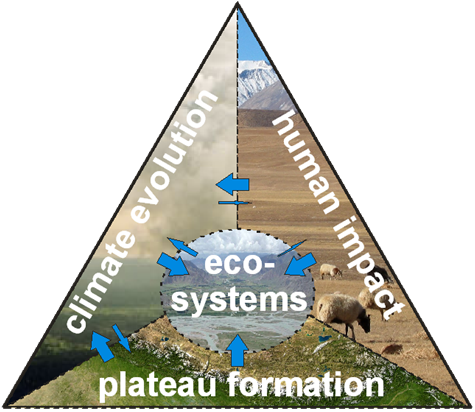Vortrag, AGU Fall meeting 2010, San Francisco, USA: 13.12.2010 - 17.12.2010
Abstract:
The Tibetan Plateau, often called the third pole, is considered as one of the most vulnerable regions being affected by global climate change. Since little knowledge is given on the effect of changing monsoon dynamics, temperature increase and increasing glacier melt on the Tibetan hydrology, a project was initiated to study their spatio-temporal impact on the regional water balance. As shown by the remote sensing based analysis of lake extent and lake level changes, the increase of the lake level of the Nam Co (30°N/90°E, 4718 m a.s.l.) in the previous decades indicates that the Nam Co basin (10 800 km²) located in central Tibet is experiencing noticeable changes in the hydrological dynamics. To quantify those changes, the distributed, hydrological model J2000 which was adapted to high-altitude conditions and extended by a glacier and a lake module. Given the limited data availability gridded global and regional climate projections (ECHAM5, CRU, APHRODITE, TRMM) were compared with measured climate data from the Nam Co station and nearby stations and processed as climate input data for the hydrological modeling. Land cover derived from Landsat data, soil information (ISRIC–World Soil Information) and topographic information were overlaid to receive spatial model entities according to the Hydrological Response Units approach. Using field-based data on soil and vegetation patterns and characteristics as well as soil moisture measurements, micro-scale process studies were performed to derive parameters and knowledge for the calibration of the model. With the model spatially distributed estimates of precipitation, potential and actual evapotranspiration from the land surface and the lake itself, glacier and snow melt and runoff generation could be obtained for the period of 1961 in 2010 in monthly and daily time steps. Comparisons with the very rarely available measured hydrological quantities showed a reasonable correlation. For example, observed lake level rise conducted by the Institute of Tibetan Plateau Research (ITP) who measured a lake level rise of 29 cm/y (2005-2008) and estimated 27cm/y (2000-2009) from radar altimetry could be reproduced by the model. The model results also reveal that glacier runoff is the major source of lake water inflow. To evaluate the basin-wide role of permafrost-driven wetlands which are understood as the most important storages in the water cycle once the glaciers disappeared, the characteristics, distribution and functioning of different wetland types are studied by combining remote sensing data and topographic information, field data on vegetation and soil as well as continuous in-situ soil moisture measurements. Linking those studies to the regional model approach will help to better understand storage dynamics of the wetlands in a spatio-temporal perspective and allow simulating the eco-hydrological response of different wetland types to altered climate conditions which can be seen as an indicator for the severity of climate change dynamics at different spatial and time scales.

